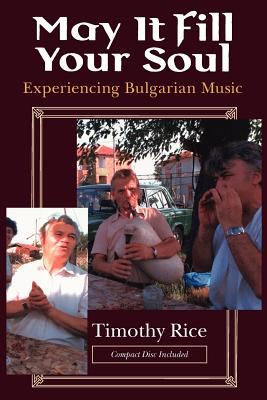 Timothy Rice, folk-dancer turned ethnomusicologist, did field work in Bulgaria for his masters degree (1971) and PhD (1977) at the University of Washington. He later hosted gaida (bagpipe) player Kostadin Verimezov and his wife, singer Todora Verimezova, for a residency in Toronto in 1978 and revisited the country during the 1980s. May It Fill Your Soul is a history and commentary on the massive changes in Bulgarian “folk” music that took place during the communist era, based on the experiences of Kostadin and Todora. The book is fairly well known among students of Balkan music and provides a different and much more detailed view than can be read in short articles, for example in The Rough Guide To World Music.
Timothy Rice, folk-dancer turned ethnomusicologist, did field work in Bulgaria for his masters degree (1971) and PhD (1977) at the University of Washington. He later hosted gaida (bagpipe) player Kostadin Verimezov and his wife, singer Todora Verimezova, for a residency in Toronto in 1978 and revisited the country during the 1980s. May It Fill Your Soul is a history and commentary on the massive changes in Bulgarian “folk” music that took place during the communist era, based on the experiences of Kostadin and Todora. The book is fairly well known among students of Balkan music and provides a different and much more detailed view than can be read in short articles, for example in The Rough Guide To World Music.
During and before the 1930s, Bulgarian village music was an integral part of the highly disciplined, patriarchal subsistence farming society. The principle instrument was the gaida. Women sang because their hands were usually occupied, as opposed to men who often watched sheep, which meant their hands were free to play instruments.
Not everyone participated in music, but for those who did, singing, playing, and dancing provided an important activity based on the seasons, and an aesthetic relief from hard work and a rigid social structure. For the Bulgarians, socializing and musical parties and celebrations were the “fun” of life. With the advent of communism, the government sought to blend village music with Western classical music, to merge the rural heritage with “clean,” urban, educated values.
In theory, there would be a national music symbolic of an ideal progressive European Bulgaria. Seemingly, though, this classically arranged music failed in both directions. No matter how “unmuddied” the music, urbanites still hated their rural history and preferred to tune in to jazz and pop from Serbia and Turkey. Villagers saw no use in “performance” music that had no soul and was useless for dancing. Wedding bands, which mixed traditional music with pop and jazz, as well as Gypsy and ethnic Turkish music, arose from the underground as families looked for a way to spend their money in a commodity-poor state.
The methodology is explained in the introduction, the most daunting, jargonistic part of the book, and one that might cause a layperson (like me) to foolishly abandon all hope of understanding this excellent work. Rice points out his intent to document Bulgarian music by using the experiences of two musicians, and this is for the most part what he does. He follows Todora and Kostadin, two exceptional village musicians from the Strandza region near the Turkish border, first describing their early and largely informal training in the village of Rosenovo, as well as the role of music in the life of the village in the years before the second world war.
At the same time he also describes his own experiences in learning to play gaida from Kostadin, giving the phases he went through in his attempt to experience the music both from a musician’s and from a cultural point of view. Rice then traces their steps within the professional structure of government-prescribed arranged folklore, where their way of life and instrument and singing styles were very much bent around “arranged folklore.” Finally, Rice looks at the future through newer gaida players, including Kostadin’s nephew Ivan, and through involvements with wedding bands.
In taking such an in-depth but geographically and topically narrow approach, Rice does not give the entire picture, but the picture he does paint is expansive and detailed. However, now that we’re in the 21st century, an entire decade (the ’90s) is missing from his book.
May It Fill Your Soul leaves one pondering a number of questions. Is “La Mystere” a useful example of Bulgaria or just a music video? How does the change from participatory to performance music parallel examples where the switch was non-coercive? What is folk music? Is the limited horizon of American folk dancers valid in itself? Were the Bulgarians better off before communism?
The book also comes with a CD whose tracks are listed at the beginning of the book and referenced in the text. Many tracks were recorded by Rice beginning in 1969; others are arranged pieces courtesy of Balkanaton and Hannibal. With isolated listening they illustrate the journey from village music to arranged folklore to wedding music; with the book, they are used to illustrate points, techniques and styles. One peppy wedding band was recorded by Rice in 1969, so the progression is not really time sequential.
(University of Chicago Press, 1994)
